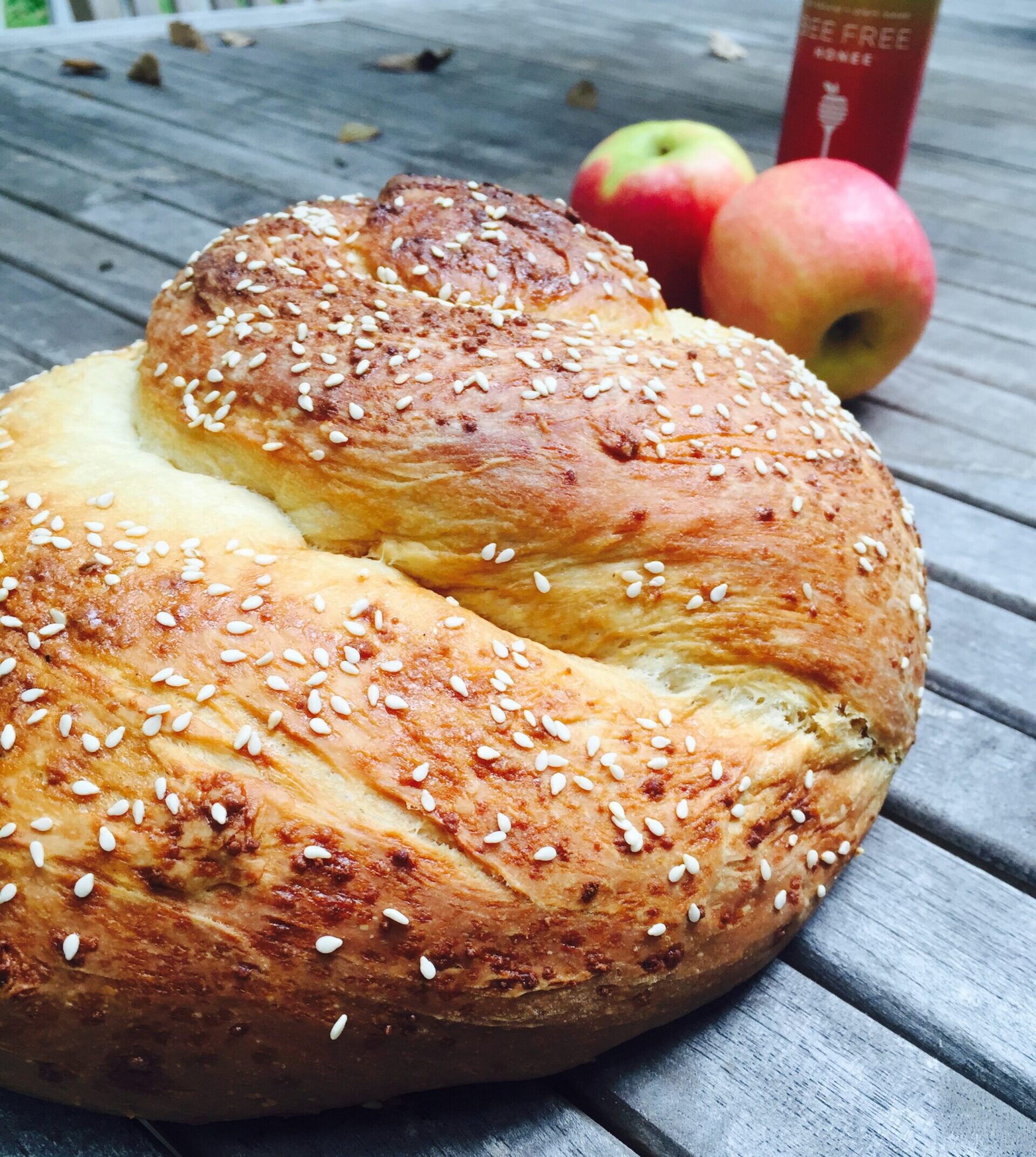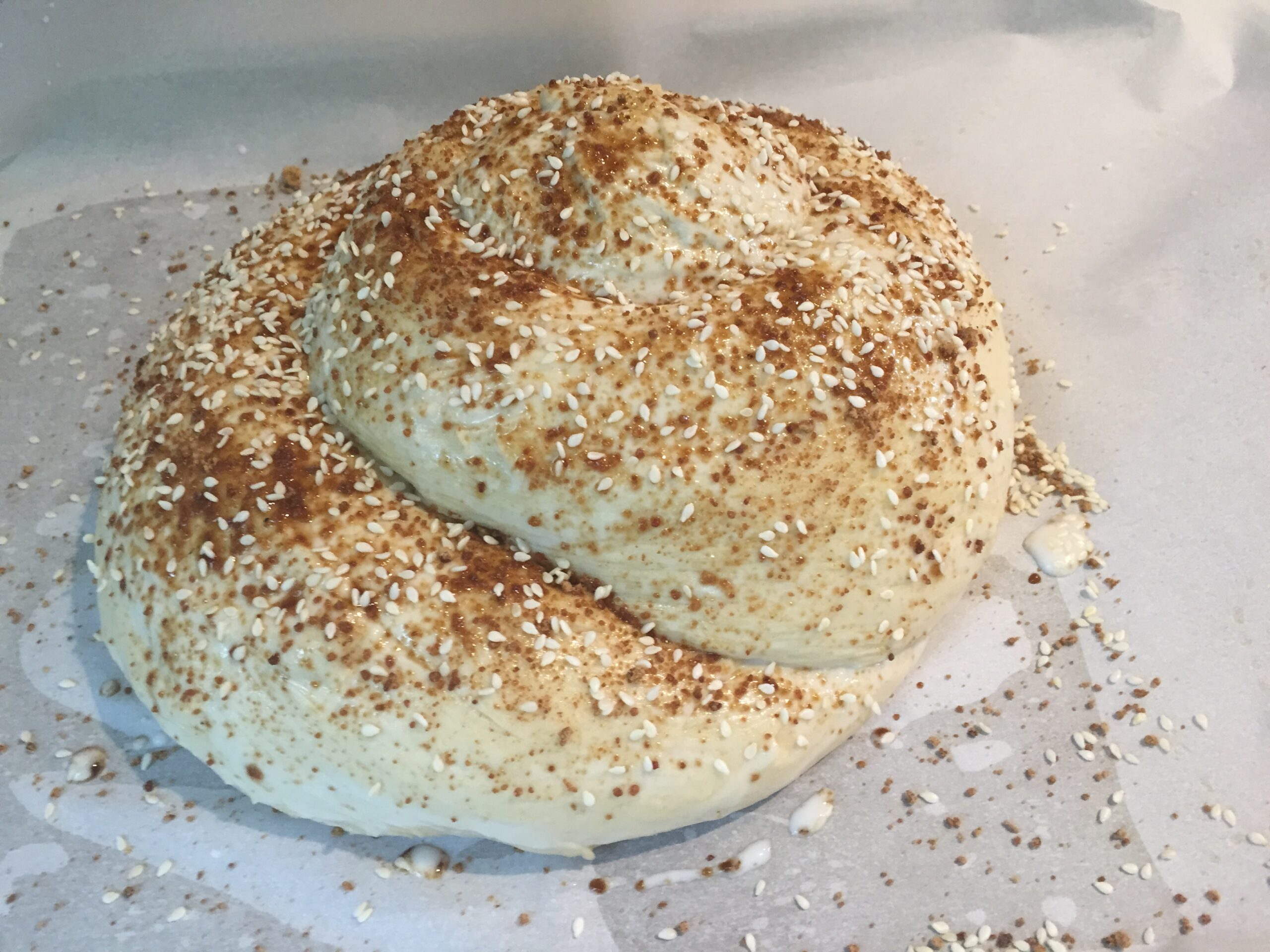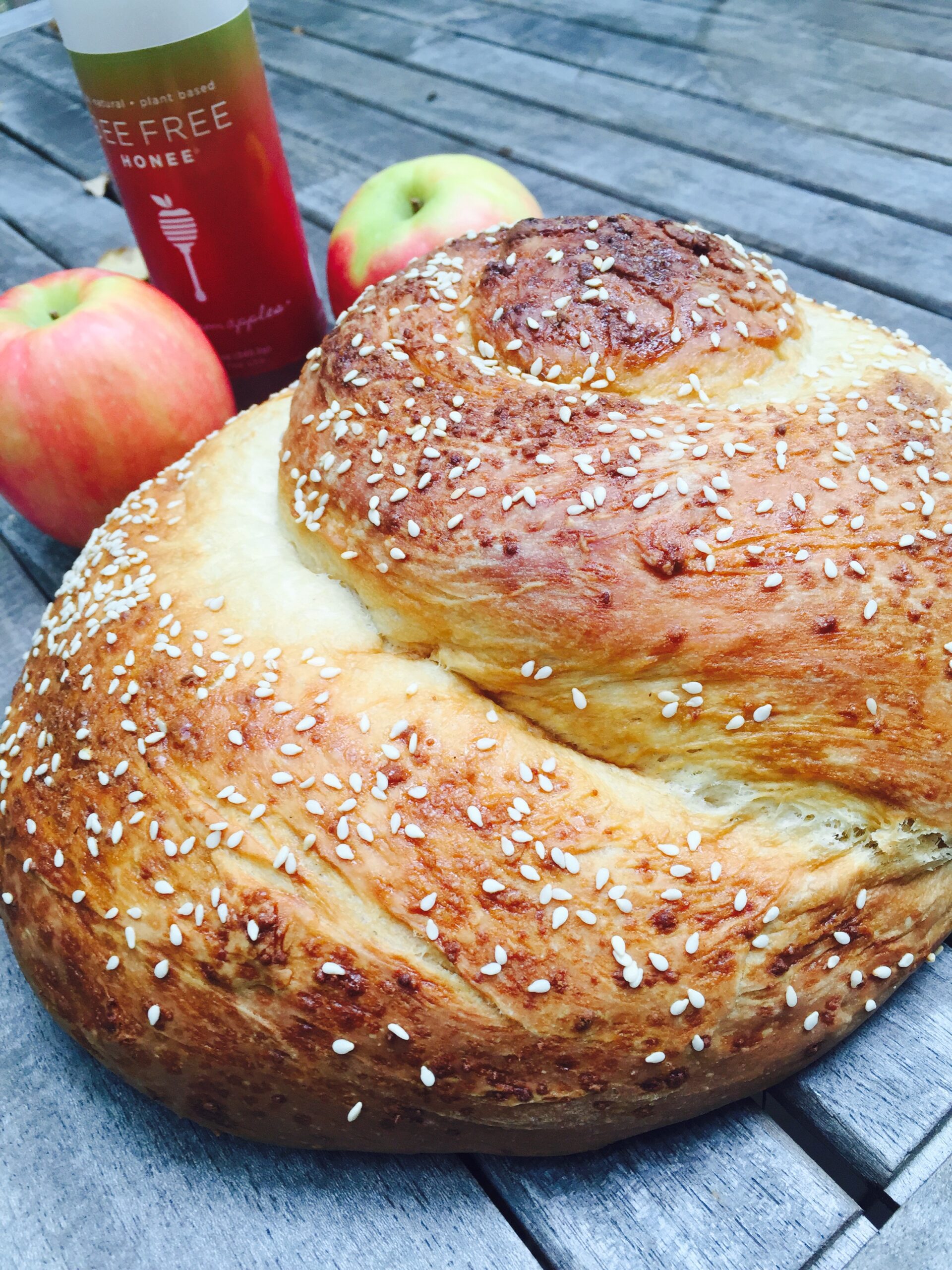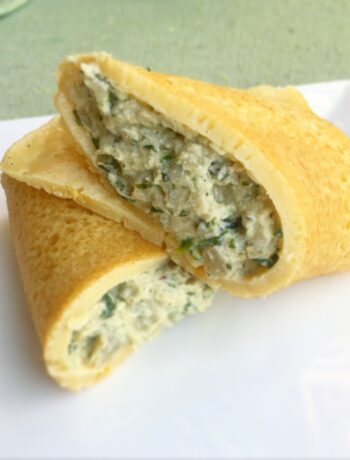
New and Improved Recipe Updated: February 2022!!
Since deciding to go vegan 7 1/2 years ago, I’ve been in search of a vegan challah recipe that can compete with my favorite eggy versions from my childhood. The kind I liked best was extra eggy, soft and cake-like challah with an extremely rich flavor and delicate crumb. I could eat slice after slice, coated with the unsalted, pareve margarine my mom kept on hand for meat meals.
Although water challah exists in the US, it’s not nearly as popular, and can be quite difficult to find. In fact despite reassurances from several friends, there was only one store in all of Manhattan that I knew would reliably have an accidentally vegan challah. Given the scarcity of options, I spent many a Friday night dinner unable to participate in the cornerstone ritual of blessing and breaking bread at the start of a meal. This is less of an issue in Israel, as it is much easier to find egg-free challah here, and at most meals there’s also a pile of soft pitas sitting next to the braided loaves.

Embarking On a Quest
My quest for the perfect challah recipe has been ongoing since a very young age. Even when I knew where to buy my favorite brand, I still always had an itch to make my own, and no matter how masterful I became in pastry creation, my challah was a perpetual disappointment, eggy or vegan. The first egg-free recipe I tried called for the unholiest of sins in my book, most especially as an egg replacer: banana. There is nothing you can say or do to make me believe that “you can’t even taste the banana!” because yes, I can, even in those super chocolatey brownies. Even the slightest hint that banana is lurking beneath the surface and the brownie/cake/smoothie/muffin/challah is ruined.
I still wanted to try that first, sinful recipe, however, so I subbed the banana for another sweet and starchy plant, namely pumpkin. I continued to use that recipe for several years, but nothing about it was even close to the challah I was trying to approximate. Several years later, I adapted a recipe from a friends mother, by merely leaving the egg out. The ratios of sweetness to breadiness was perfect, but it came out as slightly too oily.
Still, it was the best challah I’d ever made. Because I didn’t own a blender or food processor when I lived in Manhattan, blended tofu was out as an option, but my other go-to egg-replacer–non-dairy yogurt–was still on the table. Before I happened to bring that experiment to fruition, I happened upon the brioche recipe from Bittersweet Blog, which used a chickpea flour-based custard as the egg replacer. The sticky sweet brioche dough made a decent braid (and tasted delicious to boot), but it still wasn’t exactly what I was looking for in a challah.

Ultimate Challah Unlocked
For Rosh Hashanah last year, I decided to embark on yet another challah experiment, drawing inspiration from both the brioche recipe as well as from some of the other recipes I’d liked the best.
The chickpea custard gave the dough just the right amount of enrichment, so the crumb was soft and tender, with a sweet almost cakey, but not overpowering flavor. For the glaze, I mixed a bit of soymilk with a touch of silan (date syrup), which helped give the loaves a bit of sheen and that same rich color that traditional loaves have. The recipe will either make one large round loaf, or one large braid (which I prefer to bake in a loaf pan to retain more height). You can sprinkle the top with traditional toppings like poppy or sesame seeds, or you can have a bit of fun and try za’atar or paprika!
May all our meals be a little sweeter this year! שנה טובה ומתוקה! Have a happy and sweet new year!
Sweet and fluffy, this challah is as perfect as they come. It's best served still slightly warm from the oven, but can be frozen and defrosted for enjoyable results. First mix the starter, let sit about an hour, till bubbling. This is the autolyse. Add the chickpea flour to a small saucepan and mix in a little bit of the milk to form a paste, then stir in the remainder of the milk and open a low flame on your stove. Cook until thickened, stirring constantly, about 5-7 minutes. Remove from heat, then add the sugar and oil, stirring until well combined. Now add the chickpea mixture to the “autolyse” you made earlier, and mix well. Add in the flour and black salt, and begin to incorporate the mixture all together, until it forms a cohesive dough. Sprinkle your work board with a bit of flour, and begin to knead. Challah dough should be kneaded for at least 10 minutes (by hand) for optimal results. When the dough is smooth and elastic, let it rest for a minute while you clean the bowl, then dry, and coat with a small amount of oil. Shape the dough into a ball and place it into the bowl, turning it over to coat with the oil. Cover and let rise until doubled in size or overnight.
Shape your challah into two loaves or 8 rolls, let rise until doubled. For a round loaf, roll the dough into one long rope. Tie the rope into a regular knot, tucking one end underneath the loaf, while letting the other stick out just a bit. When pressed, the dough should spring back very slowly. Brush with nondairy milk once after braiding and once before baking. Bake at 350F/180C until golden brown. Fully baked loaves will sound hollow when tapped on the bottom.Ashley's Ultimate Vegan Challah
Ingredients
Instructions




Anna Daftari
September 13, 2015 at 4:39 pmWow love the look of it <3 Plus very detailed instruction which is not very often the case 😀
Love, Anna
https://annadaftari.wordpress.com/
Ashley
November 20, 2015 at 11:18 amThank you Anna!
[email protected]
September 15, 2015 at 9:52 pmEGG FREE CHALAH
Sent from Windows Mail
RECEIVED RECIPE AND GOT VERY HUNGRY…MISSED YOU AT AUNT LINDAS USUAL FEAST …THERE WASNT A CHALAH IN SIGHT..HOPE YOU ARE WELL AND COOLNG OFF BY NOW LOVE GRAMMA
ElsaCorradetti
November 20, 2015 at 11:08 amHi! Are these the correct measurements? I’ve made this recipe a couple of times and I never need more that 2.5-3 cups of flour.
It’s delicious, though! 🙂
Ashley
November 20, 2015 at 11:17 amThe flour really depends on the weather actually. I can update that for sure. I’ve always needed at least 3 cups of flour, but it’s definitely dependent on the humidity level here (which varies a lot in Tel Aviv). In the summer it generally took at least 4, sometimes more, but now I’m using a lot less.
ElsaCorradetti
November 20, 2015 at 12:15 pmAh, makes sense! I’m not a great baker so it’s nice to know I’m not doing anything wrong 🙂
Hannah
April 30, 2020 at 6:42 pmOh, she’s a beauty! Such a perfect, voluptuous spiral, too. I’m catching this post a bit belatedly, but there’s never a bad time for challah.
tipsyshades
May 3, 2020 at 12:41 pmThanks Hannah! (Honestly, this was originally published in my days of anonymity, but I just republished on my new URL here). I have even more new tricks for this recipe that should probably require a new post entirely.
Judith
July 10, 2020 at 10:11 amIs there water missing from the recipe?
I add about 3/4 cup to get the dough to bind. Comes out perfect
Judith
July 10, 2020 at 10:14 amI should add, When using 4 cups bread flour . I use all white or wholewheat or a mixture of both.
Ashley
July 14, 2020 at 6:40 amHi Judith,
In the past couple of years I’ve since changed how I make this recipe which includes more liquid, however, I generally use all purpose flour, which absorbs less water, so I frequently made this as written above. If you’re using bread flour, it’s normal to need some more water. These days, I usually start the dough with an autolyse of 1 c water, 1 c flour, and the yeast. I mix this until it’s fully combined, then leave it to sit for an hour, after which I continue with the recipe as written.